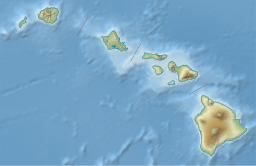Waiʻanae Range facts for kids
Quick facts for kids Waiʻanae Range |
|
|---|---|

View of the Waianae Range
|
|
| Highest point | |
| Elevation | 4,025 ft (1,227 m) |
| Prominence | 4,025 ft (1,227 m) HP of Oahu |
| Geography | |
| Parent range | Hawaiian Islands |
| Topo map | USGS Kilohana (HI) |
| Geology | |
| Age of rock | 3.9 Ma |
| Mountain type | Extinct shield volcano |
| Volcanic arc/belt | Hawaiian-Emperor seamount chain |
| Last eruption | 2.5 Ma |
| Climbing | |
| Easiest route | trail |
The Waiʻanae Range (sometimes called the Waianae Mountains) is what's left of an old shield volcano. This mountain range makes up the western part of the Hawaiian island of Oʻahu. Its highest point is Kaʻala, which is the tallest peak on Oʻahu at 4,025 feet (1,227 meters).
Contents
What Makes the Waiʻanae Range Special?
The Waiʻanae Range is different from most mountain ranges you might know. Unlike mountains formed by huge plates of the Earth crashing together, the Waiʻanae Range was created by a single volcano. This means it grew from one spot, not from long lines of rock pushing up. Its neighbor, the Koʻolau, was also formed this way.
How the Volcano Formed
The oldest lava found from the Waiʻanae volcano is about 3.9 million years old. Around 3.2 million years ago, the volcano started to change. It erupted less often, and the type of lava coming out was different. Scientists believe the volcano had its last eruption about 2.5 million years ago. This means it is now an extinct volcano.
The Volcano's Changing Shape
When the Waiʻanae volcano was active, its main center was where Lualualei Valley is today. Over a very long time, strong erosion has worn away a lot of the western side of the mountain. Because of this, the mountain you see today is much smaller than it was when the volcano was erupting.
Why Erosion is Uneven
It might seem strange, but the western part of the Waiʻanae mountain has eroded more than the eastern part. This is surprising because the eastern side gets more rain. More rain usually means more erosion.
Scientists have a theory to explain this. They think a very large landslide broke off a big piece of the western volcano. This huge landslide created faults (cracks) in the rock. These faults made the rock on the western side weaker. Because the rock was weaker, it was much easier for erosion to wear it away compared to the stronger rock on the eastern side.


